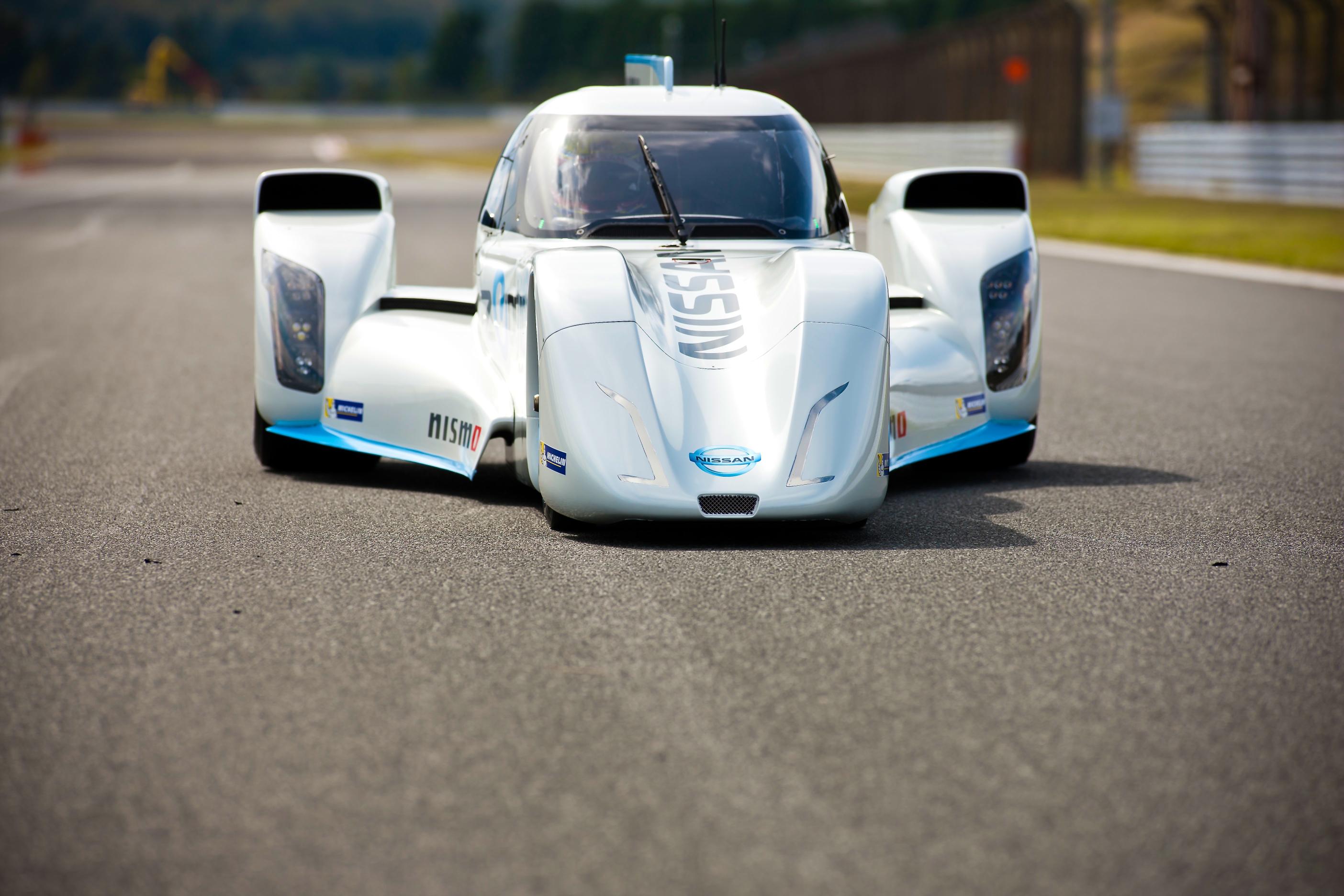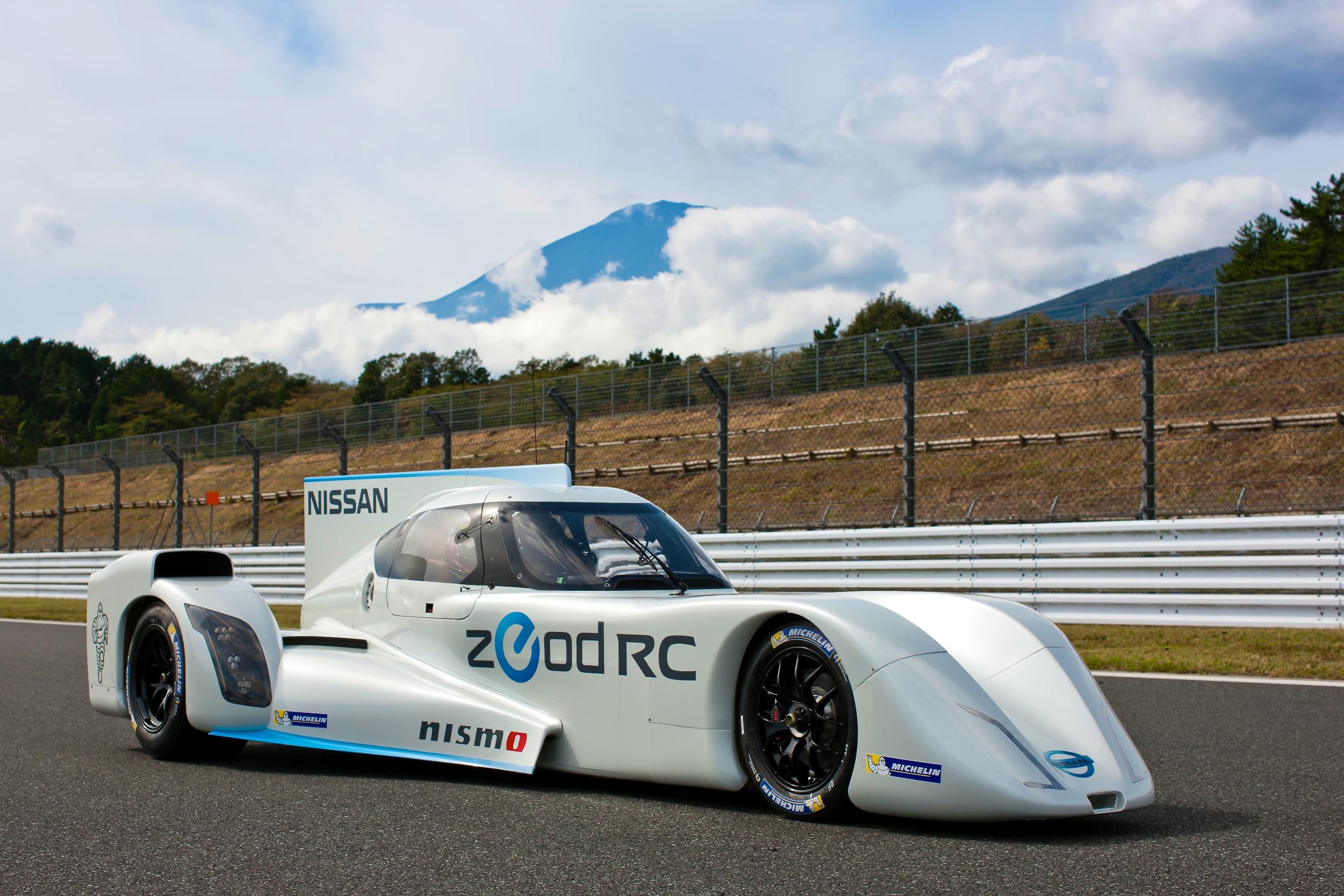- Electric prototype runs at Fuji Speedway for the first time
- Nissan’s Executive Vice-President talks about ZEOD RC
- Nissan-powered teams take top seven LM P2 positions in rain-curtailed FIA WEC race
- Fuji, Japan (Oct. 21, 2013) – Nissan’s revolutionary ZEOD RC electric prototype had its on track debut in Japan last weekend with Michael Krumm at the wheel of the car that will race at next year’s Le Mans 24 Hours.
The car was unveiled at Nismo headquarters in Yokohama on Thursday and performed three demonstration runs at Fuji Speedway in conjunction with the Japanese round of the FIA World Endurance Championship.
The Nissan ZEOD RC will complete an entire 8.5 mile lap of Le Mans next year on pure electric power at speeds in excess of 300km/h (186 mph). When running on its internal combustion engine, the ZEOD RC will recharge its battery using regenerative braking.
Key Nissan executives including Executive Vice President Andy Palmer were on site at Fuji to see the car’s debut.
The car will now head back to the UK this week to continue its testing and development program. The Nissan ZEOD RC will occupy “Garage 56” at Le Mans next year – an entry reserved for cars showcasing new and innovative technology previously not seen at the French endurance classic. Nissan will use the ZEOD RC programme to develop technologies for its planned future LM P1 assault.
“This has been a fantastic opportunity for everyone involved to bring the Nissan ZEOD RC to Japan to present the car at Nismo and then show the car at Fuji Speedway for the fans,” Nissan Global Motorsports Director, Darren Cox said.
“The reaction from the fans has been amazing – especially the young fans. We had a very poignant moment watching the car on track with Mount Fuji in the background. We know we have a very big mountain to climb to develop this electric vehicle technology for Le Mans but seeing the reaction from the young fans is a key reason why we are doing this.
“It was a pity that the weather spoiled the day on Sunday for the FIA WEC race but we were thrilled to be able to bring the car here for loyal Japanese fans.”
MICHELIN DESIGNS NISSAN ZEOD RC’S TIRES FOR LE MANS
OYAMA-CHO, Japan – Nissan ZEOD RC’s invitation to participate at Le Mans next year from the Automobile Club de l’Ouest is a tremendous technological development opportunity for the automaker, but also a ready laboratory for next-generation tires, says Michelin Director Serge Grisin.
Michelin makes more than half the tires for vehicles competing at Le Mans, but the Garage 56 status, reserved for cars with new technology, has special allure.
Grisin, speaking with the Global Media Center during the running of the World Endurance Championship at Fuji Speedway, said working with Nissan on the ZEOD project will help the tire maker in developing electric vehicle products and in bringing even better tires to consumers.
Serge Grisin, Director 4 Wheels Racing Division, Michelin:
“For Michelin, this project is really important. We’re a technical leader in the tire industry. Garage 56 is a good way for Michelin to learn more about the way to design tires for electric vehicles, and then we can imagine new technologies for the next generation of tires that will have better performance and efficiency.
“This is a really specific tire, generally for LMP car the front tire is 20 cm, and with this tire it’s 10 cm. That means that with a tire that’s two times smaller, we’ll have to develop the same road-car performance in terms of grip, in terms of longevity, and also the tire will be lighter. That means two times lighter than the standard LMP car tire, so by this way we’ll have a tire that will be smaller and lighter, that will allow the same car performance. It’s a way to improve the efficiency of the tire.
“So for the rear tire, based on the weight distribution of the car we have developed a specific tire that is more conventional, closer to standard LMP tires. It’s 40-cm width, a 15-inch tire. What is important is to adjust the tire size to the car geometry, weight distribution and aerodynamic distribution, and also to have the best possible balance for the car.
“It’s a fact we want to have the same longevity, to increase the longevity compared to standard racing tires, so we will develop specific compounds. The geometry of the car forces us to develop a front tire that is very narrow. But even with this narrow tire, we target to have a very high longevity.
“Competition is the laboratory for the street tire, and by the way of the project we are sure that we will have a lot of data from the run of the car that we will be able to use to develop the next generation of tire, and specifically for the electric cars.
“We talk about the future, but we are only at the beginning of the project. We can use a lot of simulation tools, because we want to be ready for Le Mans and we need to think about a lot of things regarding tire design. Before the car starts to run, we will start to give them the tire with the help of simulation tools that do analysis, and (make) a more efficient way to design the tire for the future.”


